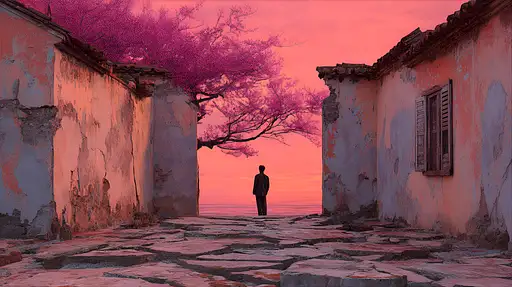


5 months ago
[Image Type: Ultra-realistic color photograph / Highly detailed realistic oil painting / High-resolution digital portrait] of Marie Curie. Facial Details: Face Shape: Oval-shaped, with slightly prominent cheekbones and a soft jawline. Skin Tone: Fair complexion with a subtle rosy undertone, showing natural skin texture and pores. Fine expressive lines are visible around the eyes and mouth, and subtle horizontal lines on the forehead (especially in older depictions). Hair: Color: A blend of light grey, silver, and pale blonde, with remnants of subtle underlying light brown strands. In younger depictions, the hair would be light brown or dark blonde. Style: Neatly gathered into a loose bun, chignon, or "messy updo" at the back of the head, with soft, wispy strands framing the forehead and temples. In younger images, the hair might be fuller around the head or styled upwards. Eyes: Color: Pale light blue or blue-grey, with a calm, discerning, and deep gaze, reflecting intelligence and seriousness. Shape: Almond to slightly round, with slightly prominent upper eyelids. Eyelashes and Eyebrows: Sparse eyelashes; eyebrows are thin to medium, naturally arched, and light-colored (tending towards grey/blonde), neatly groomed. Nose: Straight, medium-sized, with a slightly rounded tip, defined by soft shadow lines. Mouth and Lips: Medium-full lips, natural rosy-pink color, often closed with a calm or serious expression. Fine lines may appear around the mouth (especially in older depictions). Chin: Rounded and soft, proportionate to the face shape. Distinguishing Features: A subtle dimple on the chin may be present. Her facial expression conveys focus and deep thought. Body and Clothing Details (if more than the face is included): Body Build: Neck, shoulders, and upper chest are visible. Clothing: Often depicted in simple, practical attire typical of her era, such as: A dark-colored (black, navy, or dark brown) dress or jacket made of a dense fabric. Details like a high white collar, a decorative collar (as in younger photos), or simple lace embellishments on the shoulders or sleeves may be present. A simple, thin necklace with a small pendant (could be a locket or a bar-shaped pendant). Background and Lighting: Background: Simple, often a plain neutral-colored wall (grey, beige, light brown) or a softly blurred, indistinct background, with gentle color gradients providing depth without distraction. Lighting: Soft, even lighting illuminating the face, with very subtle shadows highlighting features without being harsh. The light source might be from the front or slightly to one side. Overall Mood/Feeling: Calm, serious, contemplative, and confident expression, reflecting her intelligence and profound thinking. ```

7 months ago
A hyperrealistic, exquisite photo of an unexpected moment caught perfectly: Along the sun-drenched shores of Santorini, where pristine white buildings and cobalt domes meet the endless Aegean Sea, a colossal hand appears against a clear blue sky flecked with soft, cottony clouds. This giant hand, with its lifelike texture and subtle shadows, holds an oversized ice cream cone piled high with pastel-hued scoops. In a moment of delightful absurdity, the hand tilts the cone, allowing a cascade of melting ice cream to flow gracefully over the terracotta rooftops of the picturesque village below. The sweet, slowly dripping cascade creates intricate patterns on the ancient walls, which shimmer under the gentle summer-spring light. Along the narrow cobblestone streets, locals and tourists alike--clad in breezy summer clothes--gawk in stunned amusement, their faces reflecting a blend of shock and childlike delight. Every element of the scene, from the delicate texture of the melting ice cream to the intricate details of the village architecture, is rendered in exquisite photorealistic detail, turning an ordinary Mediterranean day into a surreal celebration of whimsy and flavor.

4 months ago
The foreground is dominated by cracked, weathered stone tiles, suggesting an abandoned or ancient place. Two large, deteriorating walls frame the scene, their surfaces marked by peeling paint and rough textures. The walls are tinged with shades of pink, adding a sense of faded grandeur. On the right, a building with a tiled roof and shuttered window stands, its pinkish hue harmonizing with the rest of the scene. A vibrant tree with bright pink blossoms extends its branches from the left, injecting life and color into the otherwise desolate setting. The blossoms contrast sharply with the muted, crumbling architecture, symbolizing resilience or hope

4 months ago
The foreground is dominated by cracked, weathered stone tiles, suggesting an abandoned or ancient place. Two large, deteriorating walls frame the scene, their surfaces marked by peeling paint and rough textures. The walls are tinged with shades of pink, adding a sense of faded grandeur. On the right, a building with a tiled roof and shuttered window stands, its pinkish hue harmonizing with the rest of the scene. A vibrant tree with bright pink blossoms extends its branches from the left, injecting life and color into the otherwise desolate setting. The blossoms contrast sharply with the muted, crumbling architecture, symbolizing resilience or hope

7 months ago
polaroid, Street fashion high angle photo of a 24-year-old Ashkenazi Jew-Bosniak female exotic beauty with a warm and inviting expression. She has Medium brown skin with a natural, even glow, appearing healthy and vibrant. The skin pores and texture are clearly visible and in focus. Her Star-shaped eyes, Wide, light blue eyes, framed by long, elegant eyelashes. Her haircut is Long hair with braids and curls, haircolor is . Her eyebrows are Sleek and straight shaped, complementing her delicate facial features. Her body is Smooth, sculpted abs with visible muscle definition, small breast, toned abs, Female Bodybuilding style. Her upper body clothing is with an "edera" label sewn onto the front. Her midriff is clearly visible, Her lower body clothing is She is positioned on the left side in the frame by the rule of thirds. She stands with her back to the camera, looking over her shoulder with a slight smile, adding a playful touch to the shot. . In the background A subway tunnel with long, curving tracks, dim lighting, and graffiti-tagged walls, creating a gritty, underground feel that complements edgy, urban streetwear looks.. The scene is lighted using Bright, midday sun illuminating a historic building, creating bold shadows and highlighting the unique architectural details alongside the fashion.. the model is lighted with soft natural lighting in the style of Olivia Locher
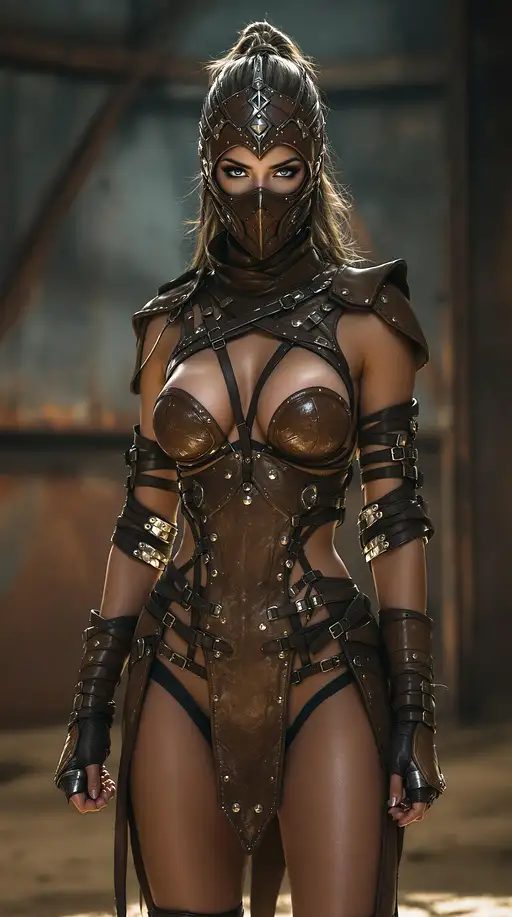
5 months ago
Full body view of A striking female figure with an athletic build is adorned in intricate brown leather armor that wraps around her body, with multiple straps and textures. Her face is partially hidden by a matching leather mask, which highlights her captivating eyes that shine with confidence. Her gloves have metal knuckles, and her feet are bare (((shows feet))) The lighting is dramatic, revealing a brilliant sheen on her skin, enhancing the fierce look of the ensemble. In the background, soft shadows create a sense of depth, suggesting an intimate setting. The figure evokes a mix of strength and glamour, conveying the atmosphere of a powerful warrior. Her fists are clenched and raised in a guard position, the metal knuckles glistening with reflected light. The setting is an arena with rusty metal walls and sand as the floor

5 months ago
Full body view of A striking female figure with an athletic build is adorned in intricate brown leather armor that wraps around her body, with multiple straps and textures. Her face is partially hidden by a matching leather mask, which highlights her captivating eyes that shine with confidence. Her gloves have metal knuckles, and her feet are bare (((shows feet))) The lighting is dramatic, revealing a brilliant sheen on her skin, enhancing the fierce look of the ensemble. In the background, soft shadows create a sense of depth, suggesting an intimate setting. The figure evokes a mix of strength and glamour, conveying the atmosphere of a powerful warrior. Her fists are clenched and raised in a guard position, the metal knuckles glistening with reflected light. The setting is an arena with rusty metal walls and sand as the floor

3 days ago
A 3D animated scene in the style of Pixar, featuring the Three Wise Men standing together in a brightly lit, opulent palace hall. The room features high, vaulted ceilings, intricate stone arches, and lavish hanging tapestries, all bathed in warm, golden hour light streaming through large windows. The first wise man is short and slim with fair skin, a bald head, and a well-groomed black beard. He has a subtly silly and joyful sparkle in his eyes as he looks directly at the audience. The second wise man is taller, fair-skinned, and skinny with a head of tousled brown hair. He looks at the audience with a neutral, intelligent, and curious expression. The third wise man has a strong, bulky build, tan skin, and a full dark beard. He regards the audience with a calm, kind, and grounded expression. All three are dressed in detailed, historically accurate traditional clothing from 1st century Judea. The Pixar-style rendering is vibrant and detailed, focusing on the unique textures of their robes and the distinct personality in each of their faces as they break the fourth wall.

5 months ago
[Image Type: Ultra-realistic color photograph / Highly detailed realistic oil painting / High-resolution digital portrait] of a young Marie Curie. Facial Details: Face Shape: Oval-shaped, with slightly prominent cheekbones and a soft jawline. Skin Tone: Fair complexion with a subtle rosy undertone, showing natural skin texture and pores. The skin should appear very smooth and youthful, with minimal to no visible lines or wrinkles. Hair: Color: Light to medium brown, possibly with hints of auburn or golden tones. Style: Often styled in an updo, with soft curls or waves framing the face. The hair may be fuller and more voluminous than in older depictions. Eyes: Color: Light blue or blue-grey, with a bright and intelligent gaze. Shape: Almond to slightly round, with a youthful openness. Eyelashes and Eyebrows: Eyelashes are present but not heavily emphasized. Eyebrows are thin to medium, naturally arched, and light brown in color. Nose: Straight, medium-sized, and well-defined, with a slightly rounded tip. Mouth and Lips: Medium-full lips, natural rosy-pink color, often closed with a calm or slightly serious expression. Chin: Rounded and soft, proportionate to the face shape. Body and Clothing Details (if more than the face is included): Body Build: Slender and youthful. Clothing: Often depicted in the fashion of the late 19th and early 20th centuries, such as: High-necked dresses or blouses, often with lace or decorative collars. Dark colors are common, but lighter tones may also be present. Background and Lighting: Background: Simple, often a plain neutral-colored wall or a softly blurred, indistinct background. Lighting: Soft, even lighting that highlights the youthful features. Overall Mood/Feeling: Intelligent, determined, and with a hint of youthful enthusiasm.

3 months ago
Create an abstract painting where the cybernetic figure emerges from and decays into pure urban filth. The 3/4 pose should barely hold together, disintegrating into a maelstrom of caustic paint effects, chemical burns, and toxic waste. The pink hair should look like it's been dragged through hell - rendered as violent, contaminated streaks that appear to be actively decomposing, with areas where the paint bubbles and splits like festering wounds. Treat the canvas like an abandoned city wall - build up thick, crusty layers of media only to deliberately destroy them. The metallic bra and leather jacket should be buried under decades of grime, suggested only through traces of corroded metal and rotting leather visible beneath layers of industrial sludge. Add thick impasto areas that crack like dried mud, revealing diseased colors beneath. Create regions where multiple paint layers interact violently - separating, bleeding, and creating chemical reactions that eat through the surface. The cybernetic elements should look like they're actively decomposing - use techniques like acid etching, rust transfers, and actual material deterioration. Let paint thinner create unpredictable decay patterns. Include areas where metallic paint oxidizes into toxic blooms and where different media repel each other like oil and water, creating leprous textures. The background should feel like a toxic waste dump - incorporate actual dirt, rust, and urban debris into the paint. Use techniques that deliberately destroy the medium: oversaturate areas until the canvas rots, allow metallic elements to oxidize naturally, encourage paint to crack and flake. Add layers of grime using dry brushing with actual ash and dirt. Create effects that suggest chemical spills, acid rain damage, and industrial accidents through caustic color interactions and material decay. The color palette should feel diseased - contaminated pinks that turn gangrenous, metals oxidized to poisonous greens, blacks that break down into putrid browns. Every color should look like it's been soaked in toxic waste and left to rot. Build up texture with actual organic matter - coffee grounds, sand, rust - anything that adds real physical decay to the surface. The entire piece should look like it was created in a contaminated zone - intentionally damaged, corroded, and infected. The paint application should appear desperate and uncontrolled, as if the artist's tools were found in a junkyard. Let accidents and material failures become part of the piece - runs, drips, chemical reactions, and decomposition should all contribute to its apocalyptic aesthetic.

7 months ago
This photograph showcases a modern, minimalist architectural structure with a focus on concrete and geometric shapes. The image is taken from within the building, looking out towards the courtyard. The dominant color is various shades of grey, ranging from the dark, almost black concrete walls to lighter, sunlit areas. The walls are smooth with a polished finish, and the overall design is characterized by sharp angles and clean lines. In the foreground, a large concrete pillar with a slightly rough texture stands out, casting shadows on the polished concrete floor. To the right, a rectangular window with a wooden frame reveals a glimpse of lush greenery outside. Further back, another set of windows with similar wooden frames allows natural light to illuminate the interior spaces. The courtyard visible through these windows is sparsely landscaped, with a few small plants and a concrete planter. The ceiling, also made of concrete, has a slightly rougher texture than the walls, indicating different construction materials or techniques. The lighting is natural, likely from the sun, casting soft shadows that emphasize the depth and structure of the building. The overall atmosphere is serene and contemplative, with an emphasis on the interplay of light and shadow.

6 months ago
Award-winning oil painting capturing a haunting nocturnal scene: a 32-year-old woman with long, wavy dark hair, disheveled and damp from the rain, leans wearily against an ancient oak tree. Her kunoichi dress clings to her form, the fabric soaked and glistening, complemented by thigh-high boots muddied from the forest floor. A weary smile plays on her lips, reflecting resilience amidst adversity. The backdrop reveals the crumbling remnants of a stone building, its walls overtaken by brambles, thorns, and blooming roses. Pale moonlight filters through the foggy night, casting ethereal glows and deep shadows, enhancing the scene's mystique. The artwork combines watercolor textures with ultra-detailed elements reminiscent of alcohol ink, oil, and acrylic painting styles, creating a rich, layered composition that evokes a sense of solitude, strength, and haunting beauty.
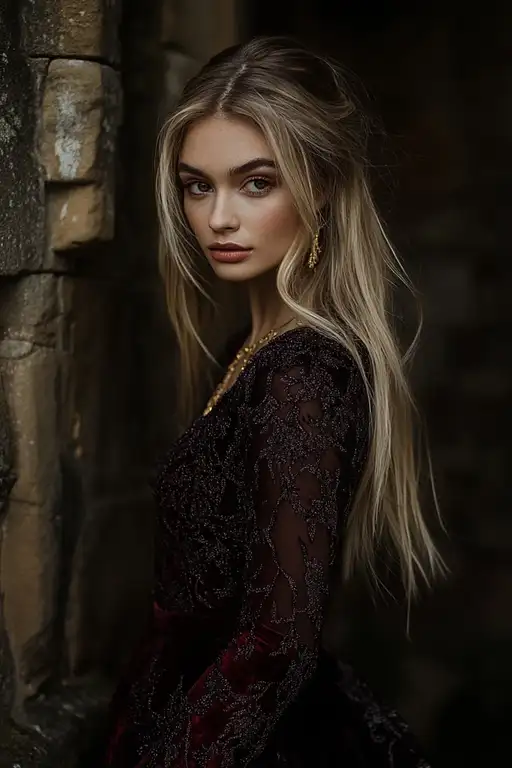
20 hours ago
A young, fair-skinned woman, with long, flowing blonde hair styled with loose waves, stands in a medieval stone building, looking directly at the viewer with a slight, alluring expression. Her eyes are a captivating shade of green, and she has delicate features, soft, full lips, and subtle makeup that enhances her natural beauty. She is wearing a deep burgundy dress made of velvet, adorned with intricate, dark lace detailing that covers her long sleeves and bodice. The dress has a high neckline and a fitted silhouette, highlighting her figure. Her ears are adorned with small, elegant gold earrings and she wears a delicate gold necklace. She is standing next to a weathered stone wall, its texture contrasting with her smooth skin and luxurious clothing. The lighting is soft and natural, with shadows that create depth and enhance the romantic, ethereal atmosphere of the scene. The image is a portrait, shot from the waist up, with a shallow depth of field, emphasizing the woman and blurring the background. The mood is elegant and mysterious. Photography style: fine art portraiture, cinematic lighting. --ar 2:3 --q 2 --s 750

6 months ago
beauty, high angle photo of a 18-year-old Gujarati-Portuguese female radiant bride with a warm and inviting expression. She has Iridescent skin with shifting colors, creating a mesmerizing, rainbow-like effect. The skin pores and texture are clearly visible and in focus. Her Eye with sharp inner edges, Bright, clear yellow eyes, framed by long, elegant eyelashes. Her haircut is Cropped fringe with shaved temple designs and pastel color highlights. Her eyebrows are neatly shaped, complementing her delicate facial features. Her body is Firm, defined biceps with a natural, athletic shape, small breast, toned abs, Female Bodybuilding style. bralette with radioactive symbols and glowing elements, suggesting the dangers of nuclear fallout, midriff, Distressed denim shorts with ripped fabric and distressed wash, Digging through a pile of debris, excitement evident as she uncovers a valuable item. She is positioned on the left side in the frame by the rule of thirds. In the background A network of overgrown highways crisscrosses the landscape, their asphalt cracked and buckled, while abandoned cars rust by the roadside. The scene is lighted Shadows dance across the walls of abandoned buildings, their movements casting eerie silhouettes that seem to come alive in the darkness. The weather is The earth shakes as earthquakes rock the landscape, causing buildings to crumble. the model is lighted with soft natural lighting in the style of Aria Darkwood
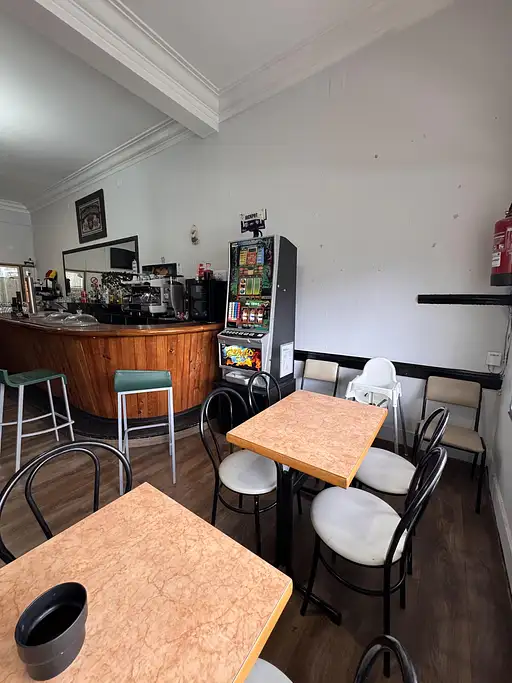
8 months ago
photorealism, interior design of a futuristic building with expansive, glowing red floors and a vast ceiling embedded with tiny lights mimicking a starry sky, walls are large slabs of textured concrete with geometric cut-outs filled with ambient light, the atmosphere is serene and otherworldly, focus on the minimalistic yet bold use of light and shadow to create a deep sense of space, UHD --ar 9:16 --style raw
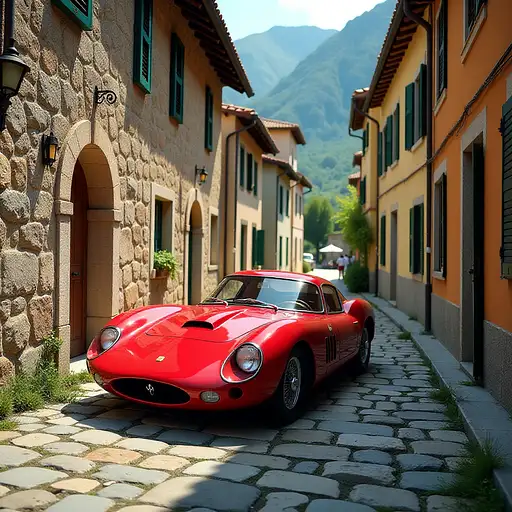
6 months ago
A sleek red race car stuck in a narrow cobblestone street of a charming Italian mountain village. The car appears wedged between rustic stone buildings with terracotta roofs and colorful window shutters. The tight alleyway winds uphill, surrounded by mountainous terrain in the background. Bright natural daylight illuminates the scene, highlighting the textures of the cobblestones and aged walls. Ultra-realistic, high detail, cinematic composition.
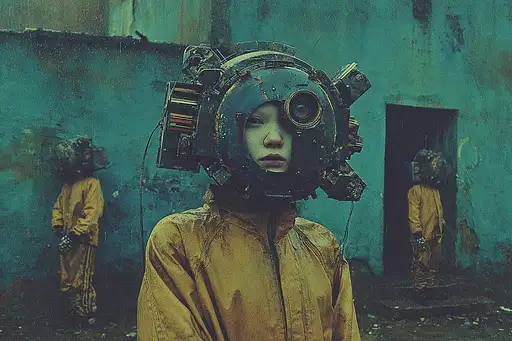
2 months ago
cyberpunk, dystopian, surreal, impressionistic ; figure wearing a rusty, antiquated metal radio headpiece and worn, faded, mustard yellow prison uniform; figure standing against a teal-green, crumbling, weathered wall; a dark, narrow doorway leading to another figure; other figure wearing a similar, mustard-yellow uniform; muted colors of the walls and uniforms, dark shadows inside the doorway; textures of metal, paint, and dirt are emphasized; a sense of isolation and decay; an old, run-down building; barefoot figures; mechanical arms; strong contrast between the vivid yellow of the clothing and the muted tones of the walls; figure in doorway is slightly blurred; a sense of melancholy, unease, and alienation. --chaos 5 --ar 3:2 --raw --profile wc7lupd ornctq4 --stylize 150

17 days ago
BLACK OPS STYLE THEME DARK, A hyper-realistic, Captured with a full-body portrait lens (around 50mm), ensuring the entire figure is framed from head to toe with natural proportions and no distortion. Centered in frame 8K fashion photo of a fit, very pale MALE . HE is sitting sideways on a matte black sport motorcycle, parked in front of a wall with vertical light wood panels. he is wearing a black hoodie, WITH TEXT SAYING "150" WITH RED HORROR FONT BIG LETTERS JACKET AND WEARING dark jeans, white sneakers, and a full black motorcycle helmet with a fully tinted visor that completely hides hIS face. A black backpack rests on HIS back. The MENS posture is relaxed and confident as he sits on the bike, one hand on the handlebar, the other resting by HIS side HOLDING AN AK-47 The lighting is natural daylight with crisp shadows. The motorcycle has sharp, clean detailing and realistic reflections. The background, outfit, and overall environment are sharp and fully in focus. HIS face is ultra-detailed and symmetrical, with highly realistic eyes. proportionate. Everything in the scene is clearly visible and detailed. Ultra-detailed: skin texture, IN NEW YORK CITY STYLE ALEY, BIG BUILDINGS

9 months ago
A hyper-realistic portrait of a female demon character with red skin and long black hair, styled with bangs and flowing down her back. She has large curved horns on her head and sharp, glowing red eyes with an intense gaze. Her facial expression is playful yet mischievous. She wears a form-fitting, sleeveless black latex bodysuit that reads "BLUE DEMON" across the chest. Her body has a toned, athletic build, with noticeable curves, and her arms are casually crossed over her torso. The demon character has small blue and silver markings on her body, adding to her otherworldly appearance. The background is a white wall with whimsical graffiti details and graffiti diamonds. The texture of the outfit should be shiny and reflective, resembling latex or leather. Her horns and skin display an organic texture.

10 days ago
Album Cover for: “Trône sur les Ruines” Format: Wide shot, full body, cinematic environment, poster-quality Ultra-realistic cinematic concept art of a Moroccan man in his late 20s — light brown skin, clean-shaven, with a short buzz cut and medium taper fade — sitting proudly and powerfully on a massive brutalist throne. His body language is heavy and dominant: legs planted wide, elbows on knees, hands gripping the throne armrests. His eyes lock directly onto the viewer — serious, furious, proud. His expression carries the weight of survival and leadership born through chaos. He looks like a street king forged in war, not luxury. The throne is enormous, crafted from cracked concrete, twisted rebar, scorched books, shattered electronics, rusted weapons, and destroyed satellite parts — a symbolic fusion of revolution and ruin. It sits atop rubble and ash. Behind him, the destroyed skyline of a Moroccan city: burned buildings, collapsed domes, broken antennas, crumbling high-rises, graffiti-scarred walls. A torn Moroccan flag flutters in the distance, hanging from a bent metal pole. The man wears a modern warrior-royalty outfit: a long dark trench coat made from military fabric, lined with faded golden Moroccan embroidery (zellige patterns), a worn bulletproof vest underneath, armored combat pants with tactical straps, and black scratched leather boots. A tattered deep red cloak is thrown over one shoulder. On his chest, a bent metal star medal — not shiny, but earned. His crown is raw and symbolic: cracked gold fused with rusted iron, dented like it survived fire — resting slightly tilted on his head. The sky is cinematic: thick storm clouds rolling in, deep greys and purples, with one sharp beam of golden-orange light breaking through — hope after destruction. Ash and dust drift in the air, adding texture and motion. Typography: “Trône sur les Ruines” in cracked gold serif font, minimalist, sharp, placed bottom right or top left. Color palette: Ash grey, Moroccan red, coal black, bronze gold, burnt orange, storm blue. Mood: Powerful, apocalyptic, victorious. A portrait of survival and reclaimed legacy. Style: Cinematic, ultra-detailed, wide angle, poster-quality realism. Inspired by Yeezus, French war photojournalism, LiveLoveA$AP, and dystopian street rebellion aesthetics. — full body shot, wide angle, cinematic composition, Moroccan ruins in full view, background visible, throne fully visible, urban destruction, ash particles, crown visible, golden light from clouds, no blur, no fantasy, hyper-detailed, realistic lighting, gritty textures

5 months ago
Full body view of A striking female figure with an athletic build is adorned in intricate brown leather armor that wraps around her body, with multiple straps and textures. Her face is partially hidden by a matching leather mask, which highlights her captivating eyes that shine with confidence. Her gloves have metal knuckles, and her feet are bare (((shows feet))) The lighting is dramatic, revealing a brilliant sheen on her skin, enhancing the fierce look of the ensemble. In the background, soft shadows create a sense of depth, suggesting an intimate setting. The figure evokes a mix of strength and glamour, conveying the atmosphere of a powerful warrior. Her fists are clenched and raised in a guard position, the metal knuckles glistening with reflected light. The setting is an arena with rusty metal walls and sand as the floor
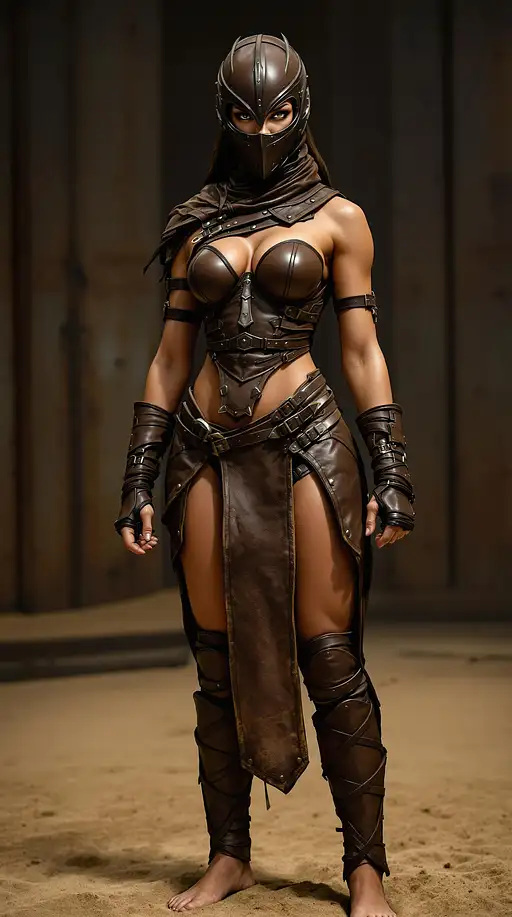
5 months ago
Full body view of A striking female figure with an athletic build is adorned in intricate brown leather armor that wraps around her body, with multiple straps and textures. Her face is partially hidden by a matching leather mask, which highlights her captivating eyes that shine with confidence. Her gloves have metal knuckles, and her feet are bare (((shows feet))) The lighting is dramatic, revealing a brilliant sheen on her skin, enhancing the fierce look of the ensemble. In the background, soft shadows create a sense of depth, suggesting an intimate setting. The figure evokes a mix of strength and glamour, conveying the atmosphere of a powerful warrior. Her fists are clenched and raised in a guard position, the metal knuckles glistening with reflected light. The setting is an arena with rusty metal walls and sand as the floor

3 days ago
A 3D animated scene in the style of Pixar, featuring the Three Wise Men standing together in a brightly lit, opulent palace hall. The room features high, vaulted ceilings, intricate stone arches, and lavish hanging tapestries, all bathed in warm, golden hour light streaming through large windows. The first wise man is short and slim with fair skin, a bald head, and a well-groomed black beard. He has a subtly silly and joyful sparkle in his eyes as he looks directly at the audience. The second wise man is taller, fair-skinned, and skinny with a head of tousled brown hair. He looks at the audience with a neutral, intelligent, and curious expression. The third wise man has a strong, bulky build, tan skin, and a full dark beard. He regards the audience with a calm, kind, and grounded expression. All three are dressed in detailed, historically accurate traditional clothing from 1st century Judea. The Pixar-style rendering is vibrant and detailed, focusing on the unique textures of their robes and the distinct personality in each of their faces as they break the fourth wall.
